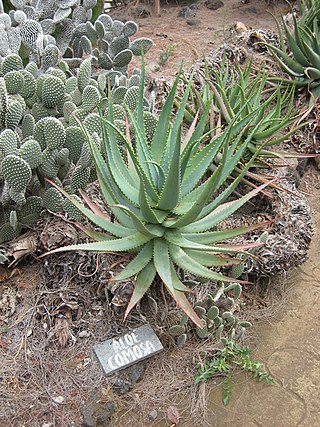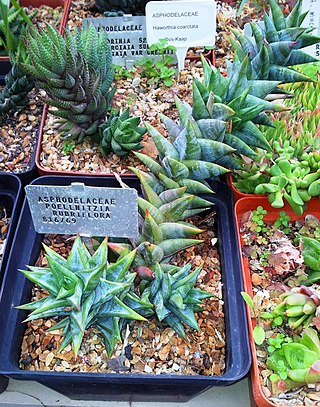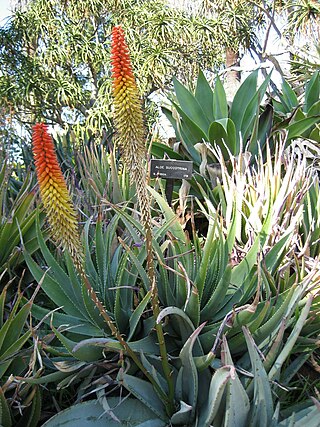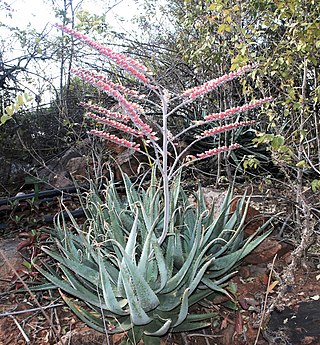
Aloe is a genus containing over 650 species of flowering succulent plants. The most widely known species is Aloe vera, or "true aloe". It is called this because it is cultivated as the standard source for assorted pharmaceutical purposes. Other species, such as Aloe ferox, are also cultivated or harvested from the wild for similar applications.

Olea capensis, the black ironwood, is an African tree species in the olive family Oleaceae. It is widespread in sub-Saharan Africa: from the east in Somalia, Ethiopia and Sudan, south to the tip of South Africa, and west to Cameroon, Sierra Leone and the islands of the Gulf of Guinea, as well as Madagascar and the Comoros. It occurs in bush, littoral scrub and evergreen forest.

Aloidendron barberae, formerly Aloe bainesii and Aloe barberae, also known as the tree aloe, is a species of succulent plant in the genus Aloidendron. It is native to South Africa northwards to Mozambique. In its native climes this slow-growing tree can reach up to 60 feet (18 m) high and 36 inches (0.91 m) in stem diameter. Aloidendron barberae is Africa's largest aloe-like plant. The tree aloe is often used as an ornamental plant. Its tubular flowers are rose pink (green-tipped); it flowers in winter and in its natural environment is pollinated by sunbirds.

Aloe comosa is a species of flowering plant in the Asphodelaceae family. It is commonly called Clanwilliam aloe) and is endemic to South Africa.

Gonialoe dinteri, the Namibian partridge aloe, is a species of flowering plant in the Asphodelaceae family. It is native to arid areas of Angola and Namibia.

Aloidendron eminens, formerly Aloe eminens, is a species of succulent plant in the genus Aloidendron, endemic to Somalia.
Aloe jawiyon is a species of succulent plant in the genus Aloe first described in 2004. It is endemic to the island of Socotra, Yemen, located in the Indian Ocean, approximately 200 miles off of the southwestern coast of the Arabian Peninsula and around 430 miles east of the coast of Somalia.

Gonialoe sladeniana is a species of plant in the genus Gonialoe. It is endemic to arid areas of central Namibia.
Aloe viridiflora is a species of plant in the genus Aloe. The species is endemic to Namibia with a wide range and is known from at least six different populations. Current trends are not known and the species is listed as LC on the IUCN Red List. However, it is scarce and Namibian authorities consider it threatened; the plant must not be removed or disturbed. It is the only known green-flowering aloe. Its natural habitats are dry savanna, subtropical or tropical dry shrubland, and rocky areas. It can produce hallucinations when ingested, leading to its occasional use in shamanic rituals.

Dudleya lanceolata is a succulent plant known by the common name lanceleaf liveforever or lance-leaved dudleya. It is an extremely variable and widely ranging species that occurs from Monterey County and Kern County in California south through Ensenada in Baja California. It is characterized by green to purple lanceolate leaves, red, orange, or less commonly yellow petals, and is typically tetraploid. Despite its diversity, it is quite stable as a species, but hybrids may be discovered with other species of Dudleya, which can make it difficult to discern in areas where numerous species converge.

Aloe hereroensis is an African Aloe native to Angola, Namibia and South Africa. Like other Aloe species, it forms a rosette of succulent, lanceolate, greyish-green leaves with teeth along their edges. These leaves can grow up to 40 cm long. A. hereroensis forms large inflorescences, up to 1 meter high, with clusters of scarlet flowers.

Astroloba rubriflora is a succulent plant found in the mountainous Karoo area around Robertson, South Africa. It is listed as a Vulnerable species on the IUCN global Red List.

Kumara plicatilis, formerly Aloe plicatilis, the fan-aloe, is a succulent plant endemic to a few mountains in the Fynbos ecoregion, of the Western Cape in South Africa. The plant has an unusual and striking fan-like arrangement of its leaves. It may grow as a large multistemmed shrub or as a small tree. It is one of the two species in the genus Kumara.

Aloiampelos, formerly Aloe ser. Macrifoliae is a genus of succulent plants in the subfamily Asphodeloideae, comprising seven species found in Southern Africa. They are typically multi-branched climbing or sprawling shrubs, with long spindly stems and a large woody base on the ground. These characteristics, as well as their soft, narrow, triangular leaves whose lower part ensheathes the stem, make them easy to distinguish.

Aloe petricola belongs to the genus Aloe in the family Asphodelaceae, and is commonly known as a stone aloe. This particular aloe is a flowering species with unique and distinct inflorescences, which make the plant easy to identify and distinguish from other Aloe plants. Aloe petricola is very popular for gardening because of its beautiful and radiant colors. Like many Aloe species, Aloe petricola is used for medical purposes, as it aids in healing wounds and minor burns.

Aloe bakeri is a species of flowering plant in the family Asphodelaceae, native to Madagascar, where it grows on rocky hills at low elevations. Growing to 10–20 cm (4–8 in) tall by 40 cm (16 in) wide, it is an evergreen perennial forming multiple rosettes of spidery succulent green or reddish-green toothed leaves, heavily mottled with white. The leaves are typically 10 cm long and bear straight or slightly curved white teeth that are 1 mm long and about 1-2 mm apart. In summer it produces red or orange, green-tipped tubular flowers. These flowers are attractive to birds, bees, and wasps, and are typically 2 cm long, borne on racemes 30 cm tall.

Dudleya ingens is a species of perennial succulent plant in the family Crassulaceae commonly known as the rock liveforever or Baja liveforever. A relatively large member of the genus Dudleya, this species has long green succulent leaves, and in April to June is characterized by pale yellow to white pink-tinged flowers topping tall, reddish inflorescences. It has a stem clothed densely with old, leathery leaves, and the inflorescence may be nodding, with the floral branches bearing the flowers tending to unfurl like the fronds of a fern. It is similar in appearance to Dudleya brittonii, but differs in range and chromosome number. This species is endemic to the state of Baja California in Mexico, being found from Santo Tomás to the southern coast of the state.

Aloe lomatophylloides is a unique species of Aloe endemic to the island of Rodrigues, in the Indian Ocean. It is part of a group of aloes which bear fleshy berries, and were therefore classed as a separate group, Aloe section Lomatophyllum.

Aloe globuligemma, commonly known as the witchdoctor's aloe, is a species of flowering plant in the family Asphodelaceae. It is native to southern Africa where it occurs in semi-desert and dry bushland. It is an evergreen, succulent, perennial plant. The plant forms large, dense clumps. It is harvested from the wild for local medicinal use.

Aloe somaliensis, the Somalian aloe, is a species of flowering plant in the family Asphodelaceae. It is an evergreen succulent perennial native to Somaliland and Djibouti in East Africa, where it grows at altitudes of 700–1,700 metres (2,300–5,600 ft) in bushland on limestone and sandstone rocks.





















